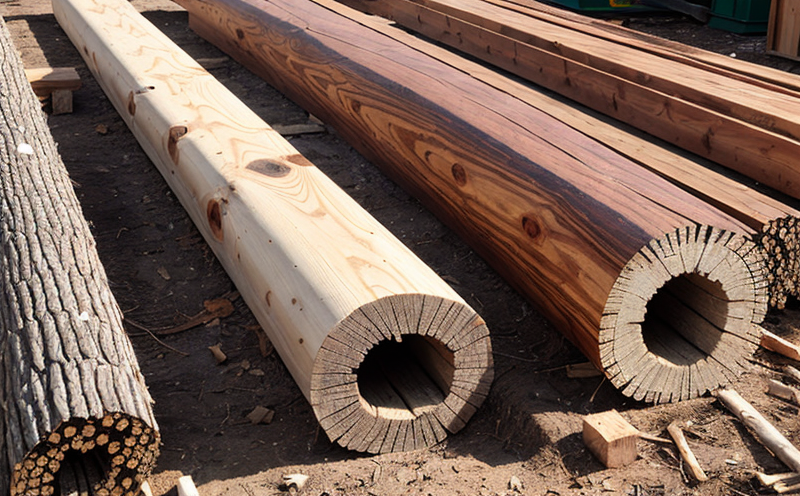Heat Aging Resistance Testing in Wood
The heat aging resistance testing of wood is a critical process used to assess the durability and stability of wooden materials under conditions that mimic real-world exposure. This test is particularly important for products intended for outdoor use, such as furniture, fence posts, and structural components. The goal is to simulate the effects of prolonged heat and moisture, which can lead to degradation over time.
Heat aging resistance testing in wood involves exposing specimens to controlled environmental conditions that replicate the stressors found in natural environments. This includes high temperatures combined with humidity levels that promote fungal growth and other biological decay processes. The test aims to evaluate how well different types of wood withstand these combined elements without significant deterioration.
During this process, the wood samples are subjected to specific temperature ranges (typically between 50°C and 120°C) for extended periods, often several weeks or months depending on the material being tested. These conditions accelerate aging processes, allowing researchers and manufacturers to predict long-term performance more efficiently.
The testing procedure begins with selecting appropriate specimens cut from various parts of the wood sample (e.g., heartwood vs sapwood), ensuring they are representative of the intended end-use application. Proper preparation ensures accurate results by eliminating variables like moisture content, which could otherwise skew test outcomes.
Once prepared, these samples undergo accelerated aging through exposure to elevated temperatures and humidity levels designed to simulate natural weathering conditions. Afterward, technicians inspect the specimens for signs of decay, discoloration, cracking, or other visible changes indicative of reduced durability. Some laboratories may also measure physical properties such as weight loss, modulus of elasticity (MOE), or impact resistance before and after testing.
Compliance with international standards like ISO 6722:1985 ensures consistency across industries globally when interpreting test results. These guidelines provide clear criteria for determining whether a particular type of wood meets specified requirements regarding heat aging resistance, enabling better decisions about material selection during product design phases.
Understanding the limitations inherent in accelerated aging tests is crucial too; while they offer valuable insights into potential long-term behavior, actual field performance can vary based on numerous factors beyond controlled lab settings. Therefore, manufacturers often follow up with additional real-world exposure trials once initial laboratory findings suggest suitable materials or treatments.
In summary, heat aging resistance testing plays an essential role in ensuring that wood products maintain their structural integrity and aesthetic appeal over extended periods despite challenging environmental conditions. By applying rigorous scientific methodologies, industry professionals can make informed choices about material sourcing and processing methods leading to improved product quality and customer satisfaction.
Applied Standards
The application of international standards such as ISO 6722:1985 is crucial when conducting heat aging resistance testing on wood materials. These guidelines outline precise protocols for preparing specimens, establishing environmental conditions, monitoring changes throughout the test period, and evaluating results based on predefined criteria.
| Standard | Description |
|---|---|
| ISO 6722:1985 | This standard specifies the method for determining the resistance of wood to heat aging. It details procedures for preparing test specimens, conditioning them under controlled environmental conditions, and assessing their physical properties after exposure. |
Environmental and Sustainability Contributions
Heat aging resistance testing contributes significantly to sustainable practices within the agriculture & forestry sectors by helping identify wood types best suited for outdoor applications. This information allows manufacturers to select materials that are less likely to degrade prematurely, reducing waste and promoting responsible resource use.
By ensuring high-quality, durable products made from heat-resistant woods, industries can minimize maintenance costs associated with frequent replacements due to premature failure. Additionally, this approach supports broader sustainability goals by encouraging the use of renewable resources while minimizing environmental impact.
The testing process also aids in developing innovative preservation techniques that extend the lifespan of wooden structures without relying heavily on chemical treatments known for negative ecological impacts. Through careful selection and treatment methods guided by rigorous testing protocols like those specified in ISO 6722:1985, companies contribute positively to both economic growth and environmental protection.
In conclusion, heat aging resistance testing plays a vital role in fostering sustainable practices within the agriculture & forestry industries. By providing valuable insights into wood performance under challenging conditions, this service supports responsible resource management and promotes environmentally friendly manufacturing processes.
Use Cases and Application Examples
| Application Example | Description |
|---|---|
| Fence Posts | Heat aging resistance testing ensures that fence posts remain structurally sound even after years of exposure to harsh weather conditions, including intense sunlight and varying temperatures. |
| Cabinetry for Outdoor Use | This type of cabinet must withstand prolonged periods outdoors without becoming damaged or discolored. Testing helps determine the most suitable wood species and treatments needed to achieve this durability. |
| Outdoor Furniture | Outdoor furniture pieces require materials that can endure continuous exposure to UV radiation, rain, humidity, and temperature fluctuations without losing their aesthetic appeal or functionality. |





